
14 minute read
Soil and Water Chemistry An Integrative Approach
Full chapter at: https://testbankbell.com/product/soil-and-water-chemistry-an-integrativeapproach-2nd-essington-solution-manual/
Chapter 2
Advertisement
Soil Minerals
2.1. Describe the four bonding mechanisms that are important in soil mineralogy. Indicate which mechanisms impart stabilityto soil minerals in a weathering environment.
See Section 2.1.
2.2. Pauling’s Fifth Rule, the Principle of Parsimony, is implied from the first four rules (i.e., it is not an explicitlystated rule in Pauling, 1960) Using the first four Pauling rules, discuss why the Principle of Parsimonymust be valid.
See Section 2.2.
2.3. Employ Pauling’s electrostatic valence principle and show that the residual charge on O2− bound to Si4+ in tetrahedral coordination can be satisfied by two Al3+ atoms in octahedral coordination or by three Mg2+ atoms in octahedral coordination.
The electrostatic valence principle (Pauling’s second rule) for the two configurations is illustrated in the figure below.
For Al3+ octahedra, each bond radiating from Al3+ has a bond strength of z/CN = +3/6 = +1/2. Each bond radiating from Si4+ has a bond strength of +4/4 = +1. A single Si4+ bond (+1 strength) plus two Al3+ bonds (2 × +0.5 = +1) exactlybalance the 2 valence of oxygen; thus, Pauling’s second rule is satisfied.
For Mg2+ octahedra, each bond radiating from Mg2+ has a bond strength of z/CN = +2/6 = +1/3. A single Si4+ bond (+1 strength) plus three Mg2+ bonds (3 × +0.33 = +1) exactlybalance the 2 valence of oxygen; thus, Pauling’s second rule is satisfied.
2.4. The Pauling rules treat ions as hard spheres with fixed ionic radii (termed the Pauling radii) In reality, the ionic radius of a coordinated metal cation is a function of the coordination number. Verify that Al3+ satisfies Pauling Rule 1 in both CN 4 and CN 6 configurations, assuming the radius of O2 is 0.140 nm, the radius of Al3+ in CN 4 is 0.053 nm, and the radius of Al3+ in CN 6 is 0.0675 nm.
In tetrahedral coordination (CN 4), the radius ratio is: which is between the limiting radius ratios of 0.225 and 0.414 for CN 4 coordination. In octahedral coordination (CN 6), the radius ratio is: r 3 Al 0.0675 0.140 0.482 which is between the limiting radius ratios of 0.414 and 0.732 for CN 6 coordination. a Be3Al2(Si6O18)
2.5. Complexityin the Si tetrahedral arrangement is the criteria used in silicate classification at the class level. On the basis of this criterion, determine the class to which each of the following minerals belongs.
Si:O = 6:18; cyclosilicates b. (Fe0.6Mg0.4)7Si8O22(OH)2
Si:O = 4:11; inosilicates (amphiboles) c Mg3Si4O10(OH)2
Si:O = 2:5; phyllosilicates d. CaMgSiO4
Si:O = 1:4; nesosilicates e. Ca6Al12Si24O72•40H2O
Si:O = 36:72 (1:2); tectosilicates (Al3+ isomorphically substitutes for Si4+) f CaMgSi2O6
Si:O = 1:3; inosilicates (pyroxenes) g. Ca2Mg(Si2O7)
Si:O = 2:7; sorosilicates
2.6. Answer the following: a. What factors affect the isomorphic substitution of one element for another in a crystal structure? b. Whyis it more difficult to remove potassium from the interlayer spaces of beidellite than from montmorillonite? c. How do chlorite and hydroxyinterlayered vermiculite differ? d. How do illite and trioctahedral vermiculite differ?
Size, as dictated by Pauling’s first rule.
The principle location of the layer charge deficit in beidellite is in the tetrahedral layer; whereas in montmorillonite it is in the octahedral layer. The layer-chargesatisfying K+ is located closer to the seat of negative charge in beidellite, relative to montmorillonite. Thus, the force of electrostatic attraction (see Equation 5.1) between K+ and a beidellite surface is greater than that between K+ and the montmorillonite surface.
Chlorite contains a continuous interlayer metal hydroxide sheet; HIV contains a discontinuous sheet; islands of metal hydroxide polymers.
Illite is dioctahedral.
2.7. The Association Internationale pour l’Etude des Argiles and the International Mineralogical Association Committee on New Minerals and Mineral Names employ a hierarchical system of mineral Divisions (or Types), Groups, Subgroups, and Species to classifythe phyllosilicate minerals (Table 2.7). Use the classification scheme to provide a species name for each of the following minerals: a.
Division: 2:1
Group: Chlorite (x is variable, anion composition O10(OH)8)
Trioctahedral chlorites
Ripidolite
Division: 2:1
Group: Brittle Mica (x ~ 1.8-2.0)
Subgroup: Trioctahedral brittle micas
Clintonite
Division: 2:1
Group: Smectite (0.2 < x < 0.6)
Subgroup: Dioctahedral smectites
Division: 2:1
Group: Vermiculites (0.6 < x < 0.9)
Subgroup: Dioctahedral vermiculites
Dioctahedral vermiculite
Group: Serpentine-kaolin (x ~ 0)
Group: Brittle Mica (x ~ 1.8-2.0) Subgroup: Dioctahedral brittle micas
Margarite
2:1
Group: Vermiculites (0.6 < x < 0.9)
Trioctahedral vermiculites
Trioctahedral vermiculite
2:1
Group: Smectite (0.2 < x < 0.6)
Dioctahedral smectites
Montmorillonite
Division: 2:1
Group: True mica (x ~ 0 85-1.0)
Subgroup: Trioctahedral micas
Phlogopite
Division: 2:1
Group: True mica (x ~ 0 85-1.0) Subgroup: Trioctahedral micas
Division: 2:1
Group: Vermiculites (0.6 < x < 0.9)
Subgroup: Dioctahedral vermiculites
Dioctahedral vermiculite
2:1
Group: True mica (x ~ 0.85-1.0)
Subgroup: Dioctahedral micas
Muscovite
Division: 2:1
Group: Smectite (0.2 < x < 0.6)
Subgroup: Trioctahedral smectites
Saponite a. Calculate the unit cell structural formula for this clay mineral. b. Compute a value for the cation exchange capacity of the mineral. c. Given that the unit cell parameters are a = 0.517 nm and b = 0.894 nm, compute a value for the internal specific surface area of the mineral. d. Estimate a value for the total surface area of the mineral (state anyassumptions).
2.8. The chemical composition of a clay mineral from the Montmorillone region of France is given in the table below.
The structural formula is determined using the method described in Table 2.10 (chemical composition excludes H2O). The results are presented in the table below.
The structural (½-unit cell) formula for the layer silicate is:
The mineral is montmorillonite
The cation exchange capacity is computed using Equation 2.4 with a unit cell layer charge of 0.8 and a molecular mass of 736.78 g mol 1 .
The internal surface area of the mineral is 2ab = 2 × 0.517 nm × 0.894 nm = 0.9244 nm 2 per unit cell. The specific surface in units of m 2 g −1 is:
If it is assumed that the internal surface of a 2:1 expansive layer silicate is 80 % of the total, then the total specific surface is 755.5/0.8 = 944.4 m2 g 1
2.9. The unit cell formulas for three phyllosilicates are indicated below. For each mineral, determine (a) the octahedral layer charge, (b) the tetrahedral layer charge, and (c) the interlayer charge. Provide the species name for each mineral.
The octahedral occupation is 2.55 + 0.12 + 1.31 + 0.02 = 4 per unit cell; the mineral is dioctahedral. The positive charge in this layer is 2.55(3) + 0.12(3) + 1.31(2) + 0.02(4) = 10.71, which satisfies a 12 charge from the surrounding anions; the layer charge is 1.29 per unit cell, or 0.645 per ½ unit cell.
The tetrahedral occupation is 7.81 + 0.19 = 8, which a layer charge equal to the Al content, or 0.19 per unit cell and 0.095 per ½ unit cell.
The charge deficit from the octahedral and tetrahedral layers is 0.645 + 0.095 = 0.74 per ½ unit cell, which places this mineral in the Vermiculite Group.
The interlayer charge is 0.45(2) + 0.15(2) + 0.26(1) + 0.01(1) = 1.47 per unit cell, or 0.74 per ½ unit cell.
The mineral is dioctahedral, and is therefore classified as dioctahedral vermiculite. This mineral is actually Otay montmorillonite, the source clay mineral SCa-3. Although the layer charge is greater than 0.6, the primarylocation of the layer charge is in the octahedral layer (in vermiculites the layer charge is primarily in the tetrahedral layer), and it is likelythat this specimen expands beyond 14.5 Å upon glycolation.
The octahedral occupation is 0.52 + 3.32 + 0.7 = 4.45 per unit cell; the mineral is dioctahedral and there is over-occupation in the layer. The positive charge in this layer is 0.55(3) + 3.32(3) + 0.7(2) = 13.01, which satisfies a 12 charge from the surrounding anions; the excess layer charge is +1 01 per unit cell, or +0.51 per ½ unit cell.
The tetrahedral occupation is 7.57 + 0.01 + 0.19 = 7.77. The positive charge in this layer is 7.57(4) + 0.01(3) + 0.19(3) = 30.88, which satisfies a 32 charge from the surrounding anions; the layer charge is 1.12 per unit cell, or 0.56 per ½ unit cell per ½ unit cell.
The charge deficit from the octahedral and tetrahedral layers is 0.51 − 0.56 = 0.05.
The interlayer charge is 0.97 per unit cell, or 0.49 per ½ unit cell.
The mineral is dioctahedral, but there is discontinuity between the layer charge (0.05 per ½ unit cell) and interlayer cation charge (0.49 per ½ unit cell)
The mineral is in the Smectite Group (low layer charge, x < 0.6) and it is dioctahedral with the layer charge principally arising in the tetrahedral layer The mineral is also high in Fe, and classifies as a nontronite (this mineral is nontronite, the source clay mineral NAu-2).
The octahedral occupation is 0.61 + 3.08 + 0.24 + 0.07 = 4 per unit cell; the mineral is dioctahedral. The positive charge in this layer is 0.61(3) + 3.08(3) + 0.24(2) + 0.07(4) = 11.83, which satisfies a 12 charge from the surrounding anions; the layer charge is 0.17 per unit cell, or 0.0.085 per ½ unit cell.
The tetrahedral occupation is 7.09 + 0.91 = 8, which a layer charge equal to the Al content, or 0.91 per unit cell and 0.455 per ½ unit cell.
The charge deficit from the octahedral and tetrahedral layers is 0.085 + 0.455 = 0.54 per ½ unit cell, which places this mineral in the Smectite Group.
The interlayer charge is 0.18(2) + 0.36(2) + 0.01(1) = 1.09 per unit cell, or 0.55 per ½ unit cell.
The mineral is dioctahedral, and is therefore classified as dioctahedral smectite. The layer charge arises principally in the tetrahedral layer and the octahedral layer is dominated by Fe. The mineral is nontronite (this mineral is a ferruginous smectite, the source clay mineral SWa-1).
2.10. A 200-mg mass of a clay mineral with a structural formula of the HNO3-HCl-HF method of Bernas. After neutralizing excess HF with boric acid the solution is placed in a 50-mL volumetric flask and brought to volume with metal-free (Type-I) water. Chemical analysis is then performed using inductively coupled argon plasma What are the concentrations of K, Na, Ca, Al, Fe, Mg, and Si in this solution?
The molecular mass of the mineral is 747.16 g mol−1 (unit cell basis). Using Si as an example, the concentration of Si in the solution is: a. Determine the ½-unit cell structural formula for the mineral. b. Name the mineral c. Compute the cation exchange capacity of the mineral. d. Compute the surface area of the mineral given that a = 0.52 nm and b = 0.9 nm.
The results are shown in the table below.
2.11. The compositional data for a 2:1 phyllosilicate is provided in the table below.
The structural formula is determined using the method described in Table 2.10 (chemical composition excludes H2O). The results are presented in the table below.
The structural (½-unit cell) formula for the layer silicate is:
The mineral is montmorillonite.
The cation exchange capacity is computed using Equation 2.4 with a unit cell layer charge of 0.56 and a molecular mass of 747.16 g mol 1 .
The internal surface area of the mineral is 2ab = 2 × 0.52 nm × 0.9 nm = 0.936 nm per unit cell. The specific surface in units of m 2 g −1 is: a. Determine the ½-unit cell structural formula for the mineral. b. Name the mineral c Compute the cation exchange capacity of the mineral. d. Compute the surface area of the mineral given that a = 0.524 nm and b = 0.917 nm.
If it is assumed that the internal surface of a 2:1 expansive layer silicate is 80 % of the total, then the total specific surface is 754.4/0.8 = 943.0 m2 g 1 .
2.12. The compositional data for a 2:1 phyllosilicate is provided in the table below.
The structural formula is determined using the method described in Table 2.10 (chemical composition excludes H2O). The results are presented in the table below.
The structural (½-unit cell) formula for the layer silicate is:
The mineral is trioctahedral vermiculite.
The cation exchange capacity is computed using Equation 2.4 with a unit cell layer charge of 0.6 and a molecular mass of 804.21 g mol 1 .
If it is assumed that the internal surface of a 2:1 expansive layer silicate is 80 % of the total, then the total specific surface is 719.62/0.8 = 899.52 m2 g 1 a. Derive the Bragg equation. b. Compute the smallest d-value that can be measured by x-raydiffraction using CuKα radiation (λ = 0.1540598 nm)
2.13. X-ray diffraction is one of the principal techniques used in mineralogical studies. The Bragg equation is used to explain how x-ray diffraction works.
The Bragg equation (Equation 2.6) is developed in Section 2.7.1.
The sin function is at its maximum value (1) when θ = 90°, or when c. Using CuKα radiation, calculate the incidence angles (°2θ) for diffractions that would indicate d-values of 0.426 nm and 0.334 nm.
°2θ = 180°. Thus, d = λ/2 = 0.1540598/2 = 0.0773 nm is the theoretical lower limit to the d-value that maybe measured using CuKα x-radiation.
Rearranging the Bragg equation:
For d = 0.426 nm, and °2θ = 20.84°. Similarly, when d = 0.334 nm, °2θ = 26.67°. d. Using CuKα radiation, create a table similar to Table 2.13, displaying the characteristic °2θ values, instead of the characteristic d-values, for the phyllosilicates.
2.14. A 200-mg mass of a clay mineral with a structural formula of K0.94Na0 06 (Al1.83FeIII Mg0.06)(Si3 11Al0 89)O10(OH)2 is dissolved using the HNO3-HCl-HF method of Bernas. After neutralizing excess HF with boric acid the solution is placed in a 50-mL volumetric flask and brought to volume with metal-free (Type I) water. Chemical analysis is then performed using inductively coupled argon plasma What are the concentrations of K, Na, Al, Fe, Mg, and Si in this solution?
The molecular mass of the mineral is 802.07 g mol−1 (unit cell basis). Using Si as an example, the concentration of Si in the solution is:
The results are shown in the table below.
2.15. The unit cell parameters for triclinic kaolinite (kaolinite-1Tc) are: a = 5.1536 Å, b =
8.9419 Å, c = 7.3906 Å, and α = 91.926º, β = 105.046º, and γ = 89.797º. Compute the dvalue for the 001 plane.
Because kaolinite unit cell is triclinic, the height of the unit cell (d-value) and the caxis dimension are not equal. The d-value will be affected by α, β, and c First, a right triangle is isolated (looking down the b-axis):
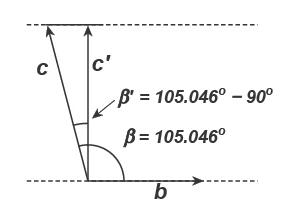
The distance c′ = c × cos(β − 90°) = 7.3906 × cos(15.046) = 7.137 Å.
Rotating the structure and looking down the a-axis:
Then, d001 = c′ × cos(α 90°) = 7.137 × cos(1.926) = 7.133 Å.
2.16. In the table below are a subset of the Miller indices and associated d-values for a mineral with β = 116.01º. Using these data, determine the remaining unit cell parameters.
The unit cell parameters are β = 116.01º, and α = γ = 90°:
The d-value for the (040) plane is a direct measure of the b-axis length: b = 4 × d040 = 4 × 3.25 = 13 Å.
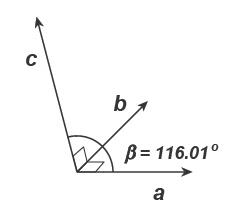
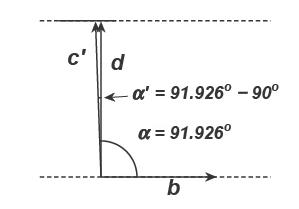
Looking down the c-axis:
The angle between the b-axis and d110 is, cos( bd110 ) = d110/b = 6.62/13 = 0.50923, or bd110 = 59.387°. The angle between the a-axis and d110 is ad110 = 90° − 59.387° = 30.613°. The a-axis length is computed using, cos( ad110 ) = d110/a. Rearranging, a = 6.62/cos(30.613) = 6.62/0.8602 = 7.692 Å.
The c-axis dimension is computed from the d001 value and the angle between the caxis and d001:
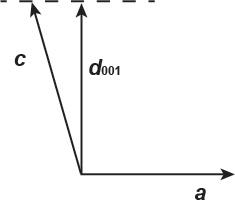
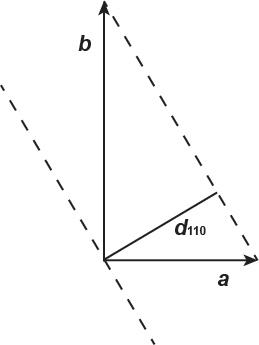
The angle between the c-axis and d001 is, 116.01° 90° = 26.01°. Then, c = d001/cos(26.01) = 6.48/0.89872 = 7.21 Å. The unit cell parameters are: α = γ = 90°, β = 116.01º, a = 7.69 Å, b = 13 Å, and c = 7.21 Å, and the unit cell is monoclinic.
2.17. The following x-ray diffraction data were obtained for a phosphate mineral using CuKα radiation (1.5418 Å). Compute the unit cell dimensions of this mineral.
Using the Bragg equation (Equation 2.6) with λ = 1.5418 Å, the °2θ values are converted to d-values:
Because the angles in the unit cell parameters are not given, it is assumed that α = γ = β = 90°. Therefore, the a- and c-axes dimensions may be obtained directly from the d200 and d010 (or d020) values: a = 2 × d200 = 2 × 3.06 = 6.12 Å; b = d010 = 5 23 Å. The c-axis dimension may be obtained from the d101 or d011 values:
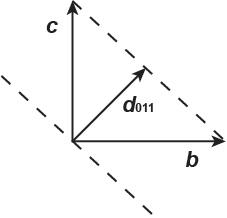
The unit cell parameters are, α = γ = β = 90°, a = 6.12 Å; b = 5.23 Å, and c = 4.83 Å and the unit cell is orthorhombic
2.18. The smallest sphere that can be placed in CN = 6 configuration (octahedron) has a radius ratio of 0.414. Prove this to be the case, irrespective of anion size, by computing the minimum radius ratio, using geometric principles, for an octahedron using both O2 (r = 0.140 nm) and F (r = 0.133 nm) as coordinating anions.
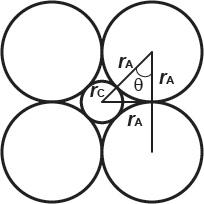
The limiting radius ratio is attained when all atoms in the coordinated polyhedron touch:
Therefore, rC/rA = 0.414, which is the limiting radius ratio for CN 6, irrespective of anion size.
2.19. You are given a soil sample and asked to determine the clay mineralogy. Beginning with the bulk soil sample, describe a methodology that could be employed to determine the clay mineralogy of the soil byx-ray diffraction. Include a discussion of any pretreatments, clay isolation techniques, and clay saturation treatments. Also, indicate how the various clayminerals respond to the imposed saturation treatments (it will be necessary to consult a reference that describes Stoke’s Law sedimentation).
See Section 2.7.3.
2.20. Determine the clay mineralogy of the clay-sized fraction of an Alfisol using the x-ray diffraction data presented below.
Using the Bragg equation (Equation 2.6) with λ = 1.5418 Å, the °2θ values are converted to d-values:
The clay mineralogy is:
Vermiculite-HIV: 14.5 Å in Mg2+-glycol that collapses to 12.8 Å (HIV) in K+saturated at room T, and to 10 Å at higher T Mica: 10 Å and 5 Å throughout
7 Å peak disappears in K+-sat, 550°C treatment
2.21. Describe how the surface charge characteristics of phyllosilicates and hydrous metal oxides differ.
The phyllosilicates bear both permanent structural charge (the ditrigonal siloxane cavity) and ionizable surface functional groups (e.g., ≡SiOH and ≡AlOH). The reactivityof these functional groups varies depending on the phyllosilicate species (as described in the relevant sections). The hydrous metal oxides bear only ionizable functional groups (described in Section 2.6).
2.22. For each of the following minerals: (1) describe (diagram) the structure and provide a structural formula; (2) indicate the locations on the mineral surface where ions may be adsorbed; and (3) identify the characteristic of the mineral that results in surface charge (how is surface charge developed and where is it located).
The structure is illustrated in Figures 2.34 and 2.35. Representative structural formulas are indicated in Table 2.7 and in Section 2.5.2.2.3. Ions may be retained in the interlayer and on the external surfaces. Surface charge is primarily generated by the isomorphic substitution of Al3+ for Si4+ in the tetrahedral layer. The ionization of ≡SiOH and ≡AlOH surface functional groups may also generate surface charge.
The structure is illustrated in Figures 2.34 and 2.35. Representative structural formulas are indicated in Table 2.7 and in Section 2.5.2.2.2. Ions may be retained in the interlayer and on the external surfaces. Surface charge is primarily generated by the isomorphic substitution of Mg2+ for Al3+ in the octahedral layer. The ionization of ≡SiOH and ≡AlOH surface functional groups may also generate surface charge.
The structure is illustrated in Figures 2.41a. The structural formula is Al(OH)3 Ions may be retained by the external surface. Surface charge is generated by the ionization of ≡AlOH surface functional groups.
The structure is illustrated in Figures 2.42a. The structural formula is FeOOH. Ions may be retained by the external surface. Surface charge is generated by the ionization of ≡FeOH surface functional groups.
The structure is illustrated in Figures 2.24. Representative structural formula is indicated in Table 2.5. Ions maybe retained in structural vacuoles and channels. Surface charge is primarily generated by the isomorphic substitution of Al3+ for Si4+ in tetrahedral coordination. The ionization of ≡SiOH and ≡AlOH surface functional groups may also generate surface charge.
The structure is illustrated in Figures 2.28. The structural formula is Al2Si2O5(OH)4. Ions may be retained by the external surface Surface charge is generated by the ionization of ≡SiOH and ≡AlOH surface functional groups.
The structure is illustrated in Figures 2.38. Representative structural formula is indicated in Section 2.5.2.2.6. Ions may be retained in structural channels. Surface

